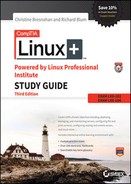Book Description
CompTIA Authorized Linux+ prep
CompTIA Linux+ Study Guide is your comprehensive study guide for the Linux+ Powered by LPI certification exams. With complete coverage of 100% of the objectives on both exam LX0-103 and exam LX0-104, this study guide provides clear, concise information on all aspects of Linux administration, with a focus on the latest version of the exam. You'll gain the insight of examples drawn from real-world scenarios, with detailed guidance and authoritative coverage of key topics, including GNU and Unix commands, system operation, system administration, system services, security, and more, from a practical perspective that easily translates into on-the-job know-how. You'll also get access to helpful study tools, including bonus practice exams, electronic flashcards, and a searchable glossary of key terms that are important to know for exam day.
Linux is viewed by many companies and organizations as an excellent, low-cost, secure alternative to expensive operating systems such as Microsoft Windows. The CompTIA Linux+ Powered by LPI exams test a candidate's understanding and familiarity with the Linux Kernel.
Review the basic system architecture, installation, and management
Understand commands, devices, and file systems
Utilize shells, scripting, and data management techniques
Navigate user interfaces, desktops, and essential system services
As the Linux server market share continue to grow, so too does the demand for qualified and certified Linux administrators. Certification holders must recertify every five years, but LPI recommends recertifying every two years to stay fully up to date with new technologies and best practices. CompTIA Linux+ Study Guide gives you the advantage of exam day confidence.
Table of Contents
- Cover Page
- Title Page
- Copyright
- Acknowledgments
- About the Authors
- Contents at a Glance
- Contents
- Introduction
- Assessment Test
- Answers to the Assessment Test
- PART I: Exam LX0-103
- PART II: Exam LX0-104
- Chapter 6: Configuring the X Window System, Localization, and Printing
- Chapter 7: Administering the System
- Chapter 8: Configuring Basic Networking
- Chapter 9: Writing Scripts, Configuring Email, and Using Databases
- Chapter 10: Securing Your System
- Appendix: Answers
- Chapter 1 : Exploring Linux Command-Line Tools
- Chapter 2 : Managing Software
- Chapter 3 : Configuring Hardware
- Chapter 4 : Managing Files
- Chapter 5 : Booting Linux and Editing Files
- Chapter 6 : Configuring the X Window System, Localization, and Printing
- Chapter 7 : Administering the System
- Chapter 8 : Configuring Basic Networking
- Chapter 9 : Writing Scripts, Configuring Email, and Using Databases
- Chapter 10 : Securing Your System
- Glossary
- Index
